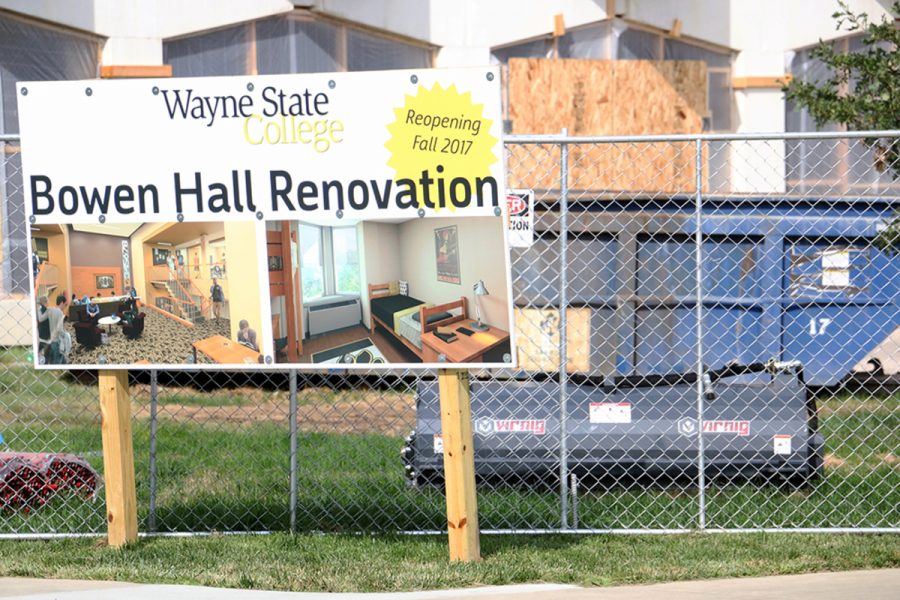Bowen at its bare bones
November 2, 2016
The skeleton of the building many students used to live in, Bowen Hall, looms on the outside border of Wayne State College’s campus, gated off to mark its largest renovation to date.
Bowen Hall was originally constructed in 1965. It was built by the Holtze Construction company, according to former construction crew member Dave Carr.
Now 69 years old, Carr joined the project as a young man, 18 years of age, the summer after graduating high school.
“When I started I was getting paid $1.65 each hour,” Carr said. “Because I came from the farm and knew how to do a few more things than some of the other help I was paid 10 cents more.”
During the original construction there was a hole left in the center of each floor that would later have to be filled, according to Carr. In that hole stood a crane that would be the way the construction crew would haul their blocks, bricks, concrete and anything else that was too heavy for traditional manpower to move.
The crane constantly had to be modified by adding new sections onto it, a new piece for each floor.
“The head boss, Joe, wanted me to learn how to operate the crane,” Carr said. “Being a teenager, however, it scared the living daylights out of me and I ended up backing out.”
In addition to the constant crane expansions, there was an elevator made out of scaffolding that required add-ons upon the completion of each floor, Carr said.
He distinctly remembers the elevator being operated by a man named Ken who had tattoos covering every part of his body and an affinity for Camel cigarettes.
The elevator was used for many different purposes and construction crew members used hand signals to get to the correct floor. Crew members would lean over the railing and hold out their hand: one finger to go to the first floor, two fingers to go to the second, so on.
“Every night everyone was taken to the ground by the elevator,” Carr said. “Workers were always in a hurry to go home so at quitting time the elevator was often past a safe weight capacity.”
Carr said that he had many different tasks as part of his job. In addition to doing miscellaneous construction tasks, he drove a dump truck to haul concrete and transported various materials with a Bobcat.
One of the most memorable moments for him happened when he forgot to let the hoist down on the dump truck, driving down the street with the back of the truck up.
“After returning to campus I finally figured out why people on Main Street were staring and pointing at me,” Carr said.
Carr summarized his experience by simply stating that there were too many lifelong learning experiences and stories to tell, but two of his most embarrassing memories include backing up a truck into the head electrician’s station wagon, where he says he first learned of Murphy’s Law, and having to undertake bathroom duty at the end of construction.
“With the building being so many floors tall, nobody wanted to ride the elevator down to use the portable toilets,” Carr said. “So they used empty five gallon buckets to do their thing and guess who got to empty those buckets when the building was completed. I did. “
It has been almost 52 years since Bowen Hall’s original construction. Time and environmental exposure have worn it down. Still, the current renovation project has perplexed some students and left them with mixed feelings when other buildings on campus are in dire need of attention and wouldn’t require relocating a large number of students.
The decision for Bowen’s renovation comes directly from the president and vice presidents, according to Vice president and Dean of Students Jeff Carstens.
“There is an overall campus master plan that includes an evaluation of all buildings on campus, including residence halls,” Carstens said. “It’s a combination of which buildings are both in the highest need of repair and maintenance, and which building is the most strategic to the institution to renovate at any particular time.”
In Bowen Hall’s case, the necessity of renovation was both strategic and needed, according to Carstens. The other residence halls on campus that have undergone renovation were smaller and primarily upper-class halls, making a large residence hall project an appealing and logical choice. In addition, the inferior window design of the ‘60s was creating problems and could have led to further issues in regards to Bowen Hall’s structure and lifespan.
“When the building was built in the mid to late ‘60s, it was designed with a single window and aluminum frames. Not very energy efficient,” Carstens said. “If you lived in Bowen Hall on the wrong winter day, snow could blow in through your windows since they just didn’t seal tightly.”
Carstens explained that while the windows were not actually dangerous, if left unchecked for much longer students wouldn’t even be able to open and close the windows properly. The replacement of the windows is considered to be the most important part of the renovation and because of Bowen’s size it is no quick job, leading the administration into deciding that getting the interior into good shape at the same time is the best course of action.
The construction continues to run smoothly with few hiccups. Steady progress means the end date to construction is still on track for July 2017.
The budget for the construction is approximately $11.9 million, according to Vice President of Administration and Finance Angela Fredrickson. The bulk of the money, roughly $9 million, is going to the construction company, Hausmann Construction, while the remainder goes to contingency maintenance and other miscellaneous aspects.
The revitalized Bowen Hall will feature an Americans with Disabilities Act compliant elevator, spacious gender-neutral bathrooms and a much more usable first floor featuring TVs, movable soft seat furniture, a game room and even a fireplace. It is expected to become the most popular residence hall on campus.









